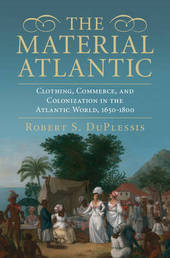
|
The Material Atlantic: Clothing, Commerce, and Colonization in the Atlantic World, 1650-1800
Hardback
Main Details
| Title |
The Material Atlantic: Clothing, Commerce, and Colonization in the Atlantic World, 1650-1800
|
| Authors and Contributors |
By (author) Robert S. DuPlessis
|
| Physical Properties |
| Format:Hardback | | Pages:367 | | Dimensions(mm): Height 237,Width 162 |
|
| ISBN/Barcode |
9781107105911
|
| Classifications | Dewey:970.03 |
|---|
| Audience | |
|---|
| Illustrations |
9 Tables, black and white; 16 Plates, color; 6 Maps; 15 Halftones, unspecified
|
|
Publishing Details |
| Publisher |
Cambridge University Press
|
| Imprint |
Cambridge University Press
|
| Publication Date |
14 October 2015 |
| Publication Country |
United Kingdom
|
Description
In this wide-ranging account, Robert DuPlessis examines globally sourced textiles that by dramatically altering consumer behaviour, helped create new economies and societies in the early modern world. This deeply researched history of cloth and clothing offers new insights into trade patterns, consumer demand and sartorial cultures that emerged across the Atlantic world between the mid-seventeenth and late-eighteenth centuries. As a result of European settlement and the construction of commercial networks stretching across much of the planet, men and women across a wide spectrum of ethnicities, social standings and occupations fashioned their garments from materials old and new, familiar and strange, and novel meanings came to be attached to different fabrics and modes of dress. The Material Atlantic illuminates crucial developments that characterised early modernity, from colonialism and slavery to economic innovation and new forms of social identity.
Author Biography
Robert S. DuPlessis is Isaac H. Clothier Professor of History and International Relations Emeritus at the Department of History, Swarthmore College, Pennsylvania.
Reviews'DuPlessis examines the interconnection between commerce and colonization in the Atlantic World, 1650-1800. More specifically, he explains the ways in which clothing (wearing, production, styles) offers a lens into the early modern Atlantic World, providing fascinating insights into global consumption, commerce, and integration during that time and place. His exhaustive research includes missionary and official records; postmortem inventories; visual images (woodcuts, paintings, etc.), which provide excellent fuel for an in-depth examination of modernity (and its place in Atlantic World history); and the role of trade and consumption in shaping society and social norms ... This sweeping text proves once more how a single item - in this case, textiles - can serve as an important lens into a wider society, adding vitality and clarity to the past. The book is beautifully done; numerous images add much to the text. This in-depth study is a must for those interested in consumption, commerce, and the textile industry. Summing up: essential.' J. Rankin, Choice 'The Material Atlantic is an ambitious, wide-ranging, and methodologically original book ... In its use of things to understand Europe's colonial encounters, it offers a compelling justification for what has been labeled the 'material turn' in historical scholarship. At the same time, it transforms our understanding of early modern Europe's engagement, both economic and cultural, with the Atlantic as a whole, from the Cape of Good Hope to Hudson's Bay.' John Styles, William and Mary Quarterly 'This is a wonderful resource for anyone interested in transnational dimensions of life in the early modern Atlantic World.' Christopher Magra, Journal of World History 'A singular study of the patterns, uses, and mores of dress in the Atlantic world of the late seventeenth and eighteenth centuries ... the author makes a deeply convincing case for treating material culture and sartorial matters as inextricable parts of the social, economic, and cultural history of the Atlantic.' Tamara Walker, William and Mary Quarterly 'This wonderfully comprehensive book uses an impressive variety of quantitative and narrative sources, including written texts and pictorial images, to illuminate the connections between producers and consumers in West and West Central Africa; the Cape Colony; British, French , Spanish and Portuguese America; and western Europe and England.' Joan Bristol, Journal of Social History 'Robert DuPlessis, in his book The Material Atlantic, examines the circulation of clothing across a wide range of socioeconomic environments scattered throughout the Atlantic world. ... DuPlessis paints a highly detailed picture of dress in the early modern Atlantic. He includes a number of helpful images and color prints to illustrate some of these points. ... Overall, DuPlessis provides a richly detailed analysis of dress regimes in the Atlantic World, one that covers immigrants and natives, rich and poor, merchants and workers, women and men.' Michael R. Lynn, The Sixteenth Century Journal 'Clothing was at the core of these diverse economic and socio-cultural phenomena. The Material Atlantic is primarily about these commercial patterns, their acquisition and uses. ... This engaging and profoundly documented account alters and extends the existing scholarship on globalization in the early modern period, the Atlantic world, and consumption. ... This wide-ranging history is invaluable to world and socio-cultural historians and their students respectively.' Adel Manai, African Studies Quarterly 'The Material Atlantic is admirable. Very few books have succeeded in fulfilling the promises and escaping the potential flaws of Atlantic history to the extent this one does. ... It is also both a global and situated history of the Atlantic world ... The fact that the book should stimulate more research on material culture in the early Atlantic world is a tribute to its great accomplishment.' Cecile Vidal, H-France 'This is a fascinating book and a major accomplishment: although dress is universal (even though some Europeans did not always see Amerindian and African styles as dress), it is often overlooked in historical studies. By bringing cloth and clothing to the fore, DuPlessis has given us a new and remarkable understanding of the Atlantic World and the many groups of people who shaped it.' Joan Bristol, Journal of Social History
|